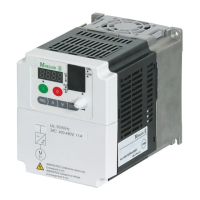09/01 AWB8230-1412GB
Connection examples
117
Connection examples
Operation through an external potentiometer
Configuration of the parameters
Method of operation
The frequency inverter can be started via terminal 1 in a clockwise
direction and via terminal 2 in an anticlockwise direction. If both
terminals are closed simultaneously, a stop command is issued.
With the externally connected potentiometer, the required
frequency setpoint (voltage setpoint) can be defined.
The measurement device can be used to display the frequency
(PNU C23 = 00) or the motor current (PNU C23 = 01). With
PNU b81, you can adjust analog output FM to the corresponding
measurement range of the measurement device (frequency or
current can be displayed).
Operation through an analog setpoint value
Configuration of the parameters
Method of operation
Inputs 1 and 2 function exactly as described in the previous
example.
With digital input 3 (configured as AT), you can switch over from
a voltage setpoint value (0 to 10 V) to a current setpoint value
(4 to 20 mA).
Instead of the wiring on terminal 3, which is fixed or realized using
a switch, you can set PNU A13 to 01. Digital input 3 is then confi-
gured as a break contact (NC).
The circuit example also includes the connection of the motor PTC
thermistor. It is important to use a screened control cable and to
lay the motor PTC thermistor cable separately from the other
motor cables. However, the screen should be grounded at the
inverter side only.
Figure 100: Connect an external potentiometer
PNU Value
Function
A01 01 Setpoint value definition via control signal
terminal strip
A02 01
Start signal via FWD/REV terminals
F02 10
Acceleration time in s
F03 10
Deceleration time in s
C01 00
FWD: Start clockwise rotation on digital input 1
C02 01
REV: Start anticlockwise rotation on digital
input 2
C23 00
Display of the output frequency (analog) via the
measurement device connected to terminals L
and FM
b81 80
Adjustment of the analog frequency display
connected to terminals L and FM
REV
FWD
24 VH
P2412FMLLOH
R
(1 – 10 kO)
–
+
0 – 10 V
1 mA
PES PES
PES
Figure 101: Analog setpoint value definition
PNU Value
Function
A01 01 Setpoint value definition via control signal
terminal strip
A02 01
Start signal via FWD/REV terminals
F02 10
Acceleration time in s
F03 10
Deceleration time in s
C01 00
FWD: Start clockwise rotation on digital input 1
C02 01
REV: Start anticlockwise rotation on digital
input 2
C03 16
AT: Changeover to current setpoint value
(4 to 20 mA)
C05 19
PTC: PTC thermistor on digital input 5
REV
AT
FWD
24 VH
P241235LLOI
4 – 20 mA
i
PESPES

